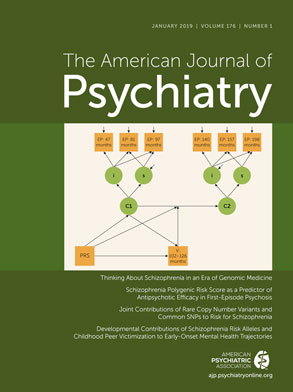I would like to begin by expressing how honored I am to be serving in the role of Editor-in-Chief for the American Journal of Psychiatry. The Journal has a long and venerable history in relation to American psychiatry and has been influential worldwide in promoting the evidence base for the care that we give our patients. I want to thank Robert Freedman for his outstanding leadership as the outgoing Editor of the Journal and congratulate him for the remarkable job that he has done with the Journal during his 13 years as Editor. During his tenure, with his thoughtful approach and continuous dedication, Bob built the Journal’s reputation to make it one of the most widely read and extensively cited journals in our field. I also want to thank the Deputy Editors who were a critical part of Bob’s team: Danny Pine, Carol Tamminga, David Lewis, Susan Schultz, Bob Michels, and John Rush, as well as the talented Editorial Board.
My aim is to continue with the strategy that has led to the Journal’s exceptional success while at the same time setting new priorities that will further enhance the Journal’s scope and relevance to our field. This opportunity to move the Journal forward comes at a crucial time in psychiatry when we are seeing increased societal acceptance of mental illness and an increased willingness to seek treatment. At the same time, there is increasing recognition, and appropriate pressure, to develop better and more effective treatments for our patients. From a neuroscience perspective, it is an awe-inspiring time. The numerous conceptual and technological advances that have occurred are enabling the discovery of the neural and molecular substrates underlying adaptive and maladaptive behavior, cognitive, and emotional responses that are relevant to psychopathology. While definitely a challenge, some of these neuroscientific discoveries hold the promise to be translated to clinical practice. I view the Journal as a vehicle not only to keep our readership informed of the exciting new developments in the science underlying our practice but also as a respected voice that will help shape future research directions, the development of novel clinical interventions, and policy decisions to support funding initiatives for research and the delivery of mental health care.
For more than 35 years, I have had an in-depth and wide-ranging involvement with our field. I have been a long-standing member of APA and for many years, at the University of Wisconsin, have led the Department of Psychiatry with a commitment to excellence in clinical care, training, and research. I see patients on a regular basis, so I am well aware of the complex issues that practitioners face, ranging from delivery of care models to reimbursement, refractory illness, and electronic medical records. In addition, I lead a robust research effort that encompasses molecular, preclinical, and human neuroimaging approaches that are focused on developing new treatment paradigms by understanding molecular and neural circuit alterations underlying the childhood risk to develop anxiety and depression. I have also had extensive experience with authors, reviewers, and editorial boards of journals as I have served on numerous editorial boards and previously served as a journal editor.
The Journal’s high impact factor of 13.391 and its 42,369 citations per year speak to its relevance and the value to the field of its published articles. The Journal is the “go to” journal for articles reporting results from the latest clinical trials as well as clinically relevant reviews and meta-analytic studies. The Clinical Case Conferences are a good complement to the original research articles and, for the practicing clinician, bring to life current scientific thinking underlying evidence-based diagnostic and treatment approaches. Additionally, the editorials written by prominent members of the field are a highlight of the Journal, providing useful summaries and insightful commentaries on the research articles.
My vision for the Journal is focused on building on these strengths by adding and integrating translational neuroscience and translational psychiatry into the current framework. After reviewing the articles published in the Journal, it is notable that there is an absence of articles that at a more basic level address mechanistic issues relevant to pathophysiology, diagnoses, and treatments. In my view, a translational perspective, bringing relevant neuroscience to the readership, will be an important and timely addition to the Journal. I believe that it is essential to emphasize the science that underlies the future of our field. Therefore, in addition to the current priorities, I will be fostering the submission of original research articles that highlight techniques and methods, many of which are being developed in nonhuman species and in vitro, that have the potential to eventually be used in humans suffering from psychiatric disorders. These include new ideas and methods relevant to imaging and computational modeling as well as circuit-based and molecular manipulations focused on remediating altered neuronal function. The latest developments in the use of gene therapy and neural stem cells for the treatment of neurodegenerative disorders are also areas to which the Journal’s readership should be exposed. Although such methods may seem like science fiction, I believe that they have the potential to be part of our future armamentarium. I want to emphasize that my intent is to balance and integrate translational neuroscience with clinical studies and to do this in a way that is accessible and engaging for the Journal’s readership.
I believe that we are at a very exciting time in psychiatry, and I am enthusiastic about serving as the Journal’s Editor-in-Chief. I look forward to working with members of our field to utilize the Journal as an important tool to better communicate scientific advances and to help set and establish priorities that will have a positive impact on the suffering that our patients endure.

